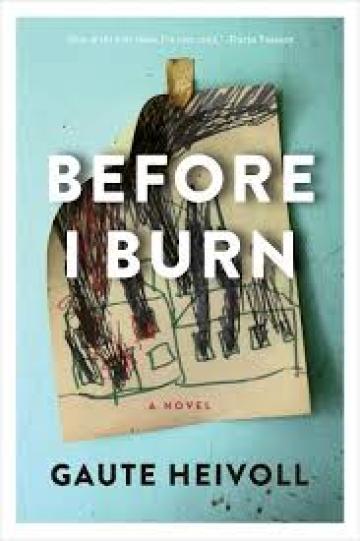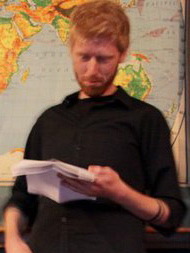BEFORE I BURN by Gaute Heivoll
Chances are you have heard someone, a creative type or otherwise, romantically reflect on their youth as a time of boundless energy when they were out to ‘set the world on fire,' or something similar to that effect. Gaute Heivoll's Before I Burn (Graywolf Press) seems almost a literal take on that notion, being a portrait of an artist, and an arsonist, as young men. As the story takes shape, Dag, the anti-villain of this sparingly elegant and engrossing mystery novel-memoir hybrid, returns to his quiet life in a small Norwegian town with his parents, Alma and Ingemann, on leave after a limited mandatory stint in the military. Even before he arrives back home, something seems off:
In the New Year, a letter was a long time in coming. However, in February they received a postcard. It showed a watchtower on the border between Norway and the Soviet Union. On the back they read: The soldier in the tower is me. At first they were excited. Just imagine! There couldn't be many parents whose son's photograph was on a postcard. Then the excitement faded. It was Ingemann who spoke first – the person in the postcard could not possibly be Dag. He bore absolutely no resemblance to their son. Alma noticed that, too, but she didn't comment.
As Dag sleeps later and later into days that are filled with not much else aside from helping Ingemann with his job of leading the Finsland Brannvesenet, the town's fire service, Alma continues her habit of noticing but not commenting on her son, and the way he seems to simmer with an unspoken angst. Because Before I Burn is a mystery about the ‘why' and not the ‘who,' pieces of Dag's psychological puzzle are gradually illuminated as the flames of each successive fire he starts reach up into the black night sky. As with any good mystery, there are layers and false leads, but the question at the heart of the story here is more satisfying for the fact that it is never tidily resolved, reflecting honestly the unknowable reaches of the human mind. Did something happen to Dag while he was away on military service that made him want to lash out, or was this rage always inside him? Might he be setting the fires to strengthen bonds, or break them?The other intertwined half of the novel is Heivoll's telling of his own artist origin story, presented more as memoir in form, though it must ultimately be allowed the same level of creative license given to Dag's half, which is also largely built out of factual accounts. Youthful unsurety about connecting with peers and choosing a career brings its own false leads and starts, until, amid the muted tragedy of his father's declining health, the sparks of his ascending future as a writer finally alight:
At three o'clock I got back into the pickup, started the engine and drove down to the ferry terminal...I read through what I already had, and then attempted to add a few more lines. The ferry came into view an hour later, and by then I must have scribbled over ten coupons. Once on board I found myself a place on my own, and there I laid out all the coupons in front of me and read through them all. I felt the roar of the engines as the ferry set off, but I was too engrossed to look up and out of the window, I was too engrossed to see the grey town disappear in the matt silver mist. I was somewhere else entirely. I sat bent over the papers, reading, adding, rewriting. However, I was only satisfied with the first text I'd written. It stood apart, it had some of my native countryside residing in it, while the other bits were more run of the mill.
Heivoll explores the connection between himself and Dag from the outset, superficial as it may be at first. “When the first building was set alight in the region of Finsland in Southern Norway at the beginning of May 1978, I was not yet two months old.” And then, “[a] month later, just before midnight on 5 June, it was all over. There had been ten fires, and it was the day after my christening....” But do Dag and Heivoll truly share something more profound than time and place? Is there something about that time and place that chemically reacts with the restlessness and neuroses of post adolescence, driving different kinds of minds toward powerful polarities? Though the incidents play no role here, it is hard to resist considering where along the spectrum between Heivoll and Dag might sit Varg Vikernes and the other members of the Norwegian black metal community that famously set fire to several Christian churches in 1992, when the author was around fourteen years old (Vikernes was arrested the following year, and convicted in 1994, for the murder of fellow musician Øystein 'Euronymous' Aarseth). Though from a different part of Norway a few hundred miles northwest of Finsland, Vikernes (despicable as he is) and his peers nonetheless might make for an intriguing third comparison, having been in those days both artists and arsonists, simultaneously pursuing (at least at one point, presumably) both creation and destruction with equal zeal. I suspect it would be very interesting to get Mr. Heivoll's take on the matter.
Gaute Heivoll's Before I Burn was a best seller in Norway. The novel won the Brage Prize and was nominated for the Critics Prize and the Booksellers' Prize, and it has been sold to more than twenty countries. Learn more about him here. Don Bartlett lives in England and works as a freelance translator of Scandinavian literature. He has translated, or co-translated, Norwegian novels by Lars Saabye Christensen, Roy Jacobsen, Ingvar Ambjornsen, Kjell Ola Dahl, Gunnar Staalesen, Pernille Rygg, and Jo Nesbo.

